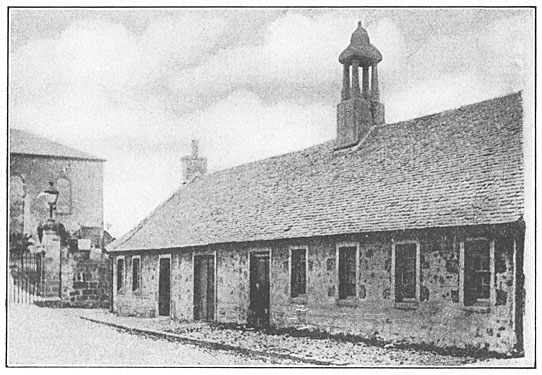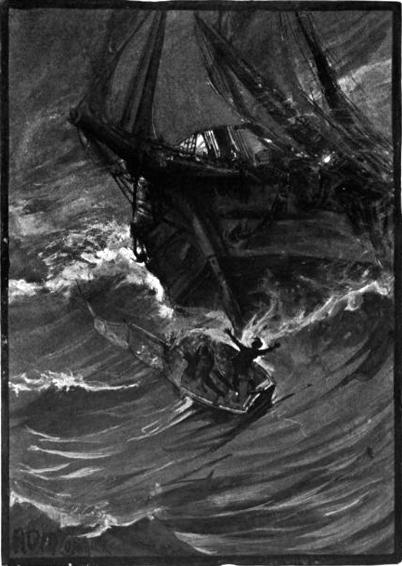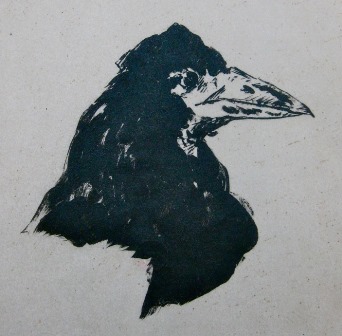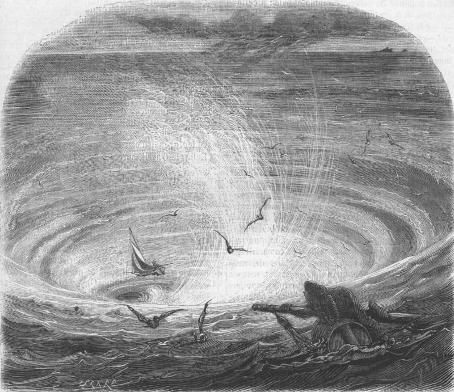It may have been that some early memories of this "dewey, misty" climate and
... the chill seas
around the misty Hebrides
were so thoroughly soaked into Edgar Poe that he long remembered the plashy fields about Irvine and Kilmarnock. [1]
Hervey
Allen, Israfel,
The Life and Times of Edger Allan Poe
(1927)
Edgar Allan Poe (1809-1849) was an American writer best known for his Gothic tales, many of which have been adapted into films. He was also a pioneer of the detective fiction and science fiction genres. Born Edgar Poe to travelling actors in Boston on January 19, 1809, he was the second of three children. After his father abandoned the family and his mother died of tuberculosis in 1811 the young Poe was taken into the home of John Allan, a Scottish merchant in Virginia who came from Irvine. He was christened “Edgar Allan Poe” on January 7, 1812 and kept this name throughout his life, though he often used the initial of his middle name, signing his name as “Edgar A. Poe” or “E. A. Poe”.
In August 1815 Edgar Allan Poe was brought to Irvine to live with John Allan's family. It is not known exactly how long Poe stayed in Irvine though he probably attended the school at Kirkgatehead, next to the parish church. Poe also visited Kilmarnock, where John Allan's sister lived, and Greenock, where Allan had business interests.

(source )
Irvine in Ayrshire, where the Allans “settled down” is in the heart of the Burns country, and was at that time a lovely little seaport on the north bank of the river of the same name crossed by a picturesque old stone bridge. Here Poe must often have stood to watch the ships, or have crossed on excursions with his father's young cousins and nephews, the Galt or Fowlds boys, over the river to Seagate or Stonecastle nearby, both picturesque ruins. An academy had been founded at Irvine centuries before the Allans arrived, and there during the Summer of 1815 he was sent to school, doubtless in company with several of his "cousins."
Hervey Allen - Israfel, The Life and Times of Edger Allan Poe
The BBC Radio Scotland programme 'Scots Gothic: A Portrait of Edgar Allan Poe in Ayrshire', first broadcast in 2007, explores the local tales and traditions that could have influenced the young Poe and his later works. According to oral history, one of the school lessons during Poe's stay in Irvine involved recording epitaphs of gravestones in the kirkyard next to the school. Local historian Billy Kerr refers to the grave of a ship's captain which may have had an impact on Poe after his voyage across the Atlantic:
Pray, gentle reader, drop a tear at his untimely fate; You like him may dread no fear, And dangers you await. He that gave can take away that life that was his own, Either on the briny sea or lands in frozen zone.
Poe researcher Robert Brill suggests the sea voyage combined with life in a coastal town hearing stories of shipwrecks had a distressing effect on the six year old Poe. He appears to have viewed the sailing with some trepidation as John Allan writes a day before departure that “Ned [Edgar] cared but little about it, poor fellow”. However, three months later, in a letter from Greenock John Allan passes on the following message from his young foster son:
Edgar says Pa say something for me, say I was not afraid coming across the Sea.

Illustration
from The
Narrative of Arthur Gordon Pym
by
Edgar Allan Poe. (source)
In Israfel: The Life and Times of Edgar Allan Poe author Hervey Allen states, “It may have been that he saw Ailsa Rock glimmering far out at sea of which Keats wrote about the same time. These coasts seem to have affected the sea poetry of Keats, and it is certain that much of the poetry of Poe deals with a craggy and mist-veiled region.”
Poe's poem Alone refers to his childhood years. It was written in 1829, shortly after the death of his foster mother Frances Allan.
From
childhood's hour I have not been
As others were — I have not
seen
As others saw — I could not bring
My passions from a
common spring —
From the same source I have not taken
My
sorrow — I could not awaken
My heart to joy at the same tone
—
And all I lov'd — I
lov'd alone —
Then
—
in my childhood — in the dawn
Of a most stormy life — was
drawn
From ev'ry depth of good and ill
The mystery which binds
me still —
From the torrent, or the fountain —
From the red
cliff of the mountain —
From the sun that 'round
me roll'd
In its autumn tint of gold —
From the lightning in
the sky
As it pass'd me flying by —
From the thunder, and the
storm —
And the cloud that took the form
(When the rest of
Heaven was blue)
Of a daemon in my view

Illustration
from The
Raven
by Édouard Manet. (source)
Edgar Allan Poe and Jules Verne
Is
all that we see or seem
But a dream within a dream?
Edgar Allan Poe, A Dream Within A Dream
Again and again I “dreamed that I was dreaming.” Now - this is an observation made by Edgar Poe - when one suspects that one is dreaming, the waking comes almost instantly.
Jules Verne, The Sphinx of the Ice Fields
Edgar
Allan Poe gained a favourable reputation in France after his stories
were translated by the French poet Charles Baudelaire. Poe's
work was highly regarded by a number of French writers and artists
such as the painter Édouard
Manet and novelist Jules
Verne. Manet
illustrated a book-length translation of Poe's The
Raven,
published as Le Corbeau.
In
1864 Jules Verne wrote an essay
on Poe entitled Edgard
Poë et ses oeuvres (Edgar Poe and his works)
where he praised
Poe as “an
American novelist of high reputation... the
leader
of the school
of the strange”.
Verne's novel The
Sphinx of the Ice Fields (1897)
was written as a sequel to Poe's
Narrative
of Arthur Gordon Pym (1838). Elements
of two of Verne's most famous novels, Journey
to the Centre of the Earth and Around
the World in Eighty Days, are
thought to be derived from Poe's stories. The
cipher in Journey
to the Centre of the Earth (1864)
may
have been based on Poe's cryptogram in
The
Gold Bug
(1843).
Other
possible "borrowings" from Poe are mentioned by William
Butcher in his introduction to
Journey
to the Centre of the Earth.
Verne's novel The Underground City, which is partly set in Irvine and Dundonald, has been described by William Butcher as a 'follow up' to Journey to the Centre of the Earth.

Descent into the Maelstrom illustration from Edgar Poe and his Works by Jules Verne. (source)
In Edgar Poe and his Works Verne briefly mentions Poe's adoption by John Allan and their travels to England and Scotland. Verne makes no mention of where in Scotland Poe stayed and there is no evidence he knew of Poe's connection to Irvine. It is however a remarkable coincidence that Verne, who was greatly inspired by both Scotland and Poe, should set one of his strangest novels in Irvine, the Scottish home of Poe, whose name became a byword for the strange and unsettling.

Sources and further reading:
Allen, Hervey. Israfel, The Life and Times of Edger Allan Poe. 1926
Strawhorn, John. The History of Irvine, Royal Burgh and New Town. 1985.
Thomas, Dwight and Jackson, David. The Poe Log: A Documentary Life of Edgar Allan Poe, 1809-1849.
Verne, Jules. Edgard Poe et ses œuvres.
Verne, Jules. Journey to the Centre of the Earth, Introduction by William Butcher
BBC Radio Scotland – Scots Gothic – A Portrait of Edgar Allan Poe in Ayrshire
Future Museum – Edgar Allan Poe
Text, excluding quotes and extracts, copyright © John Loney